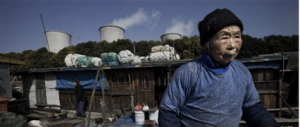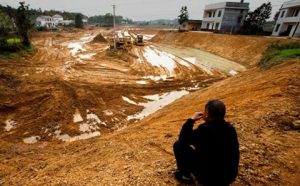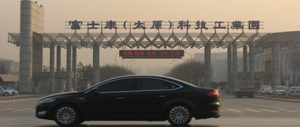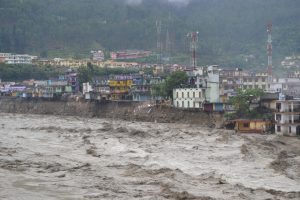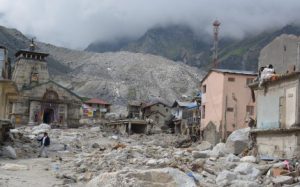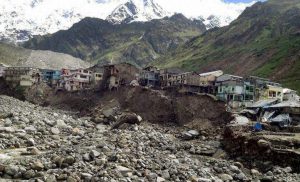One of the key fault lines of inequality in China is the rural-urban divide. Rural China has been the engine of much development through industrialisation; through farming to provide food for China’s cities; and through land grabs which open new areas for investment and government revenue.
Yet the benefits of such development are distributed unfairly. Many rural residents either do not benefit directly from development or do so at great cost to their health. These inequalities are compounded by the continued disparity in welfare provision between rural and urban areas.
Welfare provision in China’s countryside has improved after the introduction of rural healthcare cooperatives in recent years, but it remains limited. Illness is as an extreme embodiment of routinized and recurrent forms of social suffering and exclusion from various forms of care and welfare. As I document in my book, Fighting for Breath, a population’s attempt to secure care is both a physical and a social struggle to maintain integrity and to ensure family and neighbourly support.
Over the past decade, I have spent almost two years living in rural China and researching attitudes to development, illness, pollution and morality. This has brought me to witness first-hand some of the often unthinkable suffering rural villagers face (environmental and otherwise), as well as poignant moments of human dignity, kindness and resilience. I will always remember a woman in her fifties salvaging roof tiles before she demolished by hand her own newly built home to make space for a road. A seventy-year-old woman refusing treatment for glaucoma — because ‘one eye is enough’ — whilst opting to save the money for her grandson’s education. My host tending to her dying father (suffering from oesophagal cancer) as he spat blood into newspaper scraps. Sixty-year-old Uncle Wang committing suicide by drinking pesticide in the final stages of stomach cancer. His wife, a few years later, scavenging plastic bottles in the township to boost the family’s income and support her granddaughter’s education. Villagers growing crops in fields they know to be severely polluted. An anti-incinerator activist lying in bed surrounded by flies next to his sick wife after suffering a stroke.
China’s rapid emergence as an economic power since the early 1980s has been accompanied by growing concerns over its environmental impacts, particularly in terms of pollution. Food safety scandals, large-scale pollution accidents and widespread, persistent and routine pollution feature regularly in the media, both within China and beyond it.
Suffering in silence
Clusters of cancer, infertility, birth defects and other pollution-related health problems are a major matter of concern for China’s citizens. They are increasingly taking action through civil litigation, complaints and petitions to state institutions – efforts aided by environmental NGOs, the media, and the effect of mass protest. Academic studies have drawn attention to the role the media, ENGOs and civil litigation as potential forces in aiding environmental protection. But most environmental suffering takes place far from the purview of journalists, courts and NGOs. Equally, the everyday struggles of people living with pollution are hugely diverse. Citizen action is often small in scale, relatively unorganised and is premised rather differently from the language of the media, courts and NGOs.
Studies of environmental consciousness tend to focus on urban middle classes, giving the false impression that rural populations are either unaffected, do not know or do not care. My research in severely polluted sites in Yunnan, Hunan and Guangdong provinces has convinced me that villagers have a sophisticated awareness of the risks they face.
However, in the majority of cases, they suffer in silence, are unsuccessful in their attempts to put an end to pollution, or are co-opted by polluting enterprises into seeing it as inevitable. This is especially the case when not only the local (and central) government depend on industry, but people themselves rely on them for employment.
Such reliance is at its starkest in areas which have traditionally been poor and have few other sources of income. There, local governments face hard trade-offs between long-term sustainability and short term needs to provide employment and support public services. As a result, environmental regulations are largely overlooked with the acquiescence of locals, raising troubling questions over their potential for aiding environmental protection.
These instances of self-denial make difficult any attempt to determine the extent to which rural residents feel they have attained anything approximating to an adequate life, let alone a good life. Their parameters of what constitutes a good life have been adjusted to what they conceive as possible. A clean environment is not on their list of possibilities.
A potential for protest?
This is surely the deepest manifestation of environmental injustice: not only do they live with pollution, but they do not feel entitled to demand any better. The result is a co-opted environmental health consciousness, an awareness of pollution’s harm to the environment and human health, mixed with disempowerment to oppose it. This highlights villagers’ deep ambivalence about development and modernisation and some of the new fault lines of inequality and social conflict, which they generate. Whether and how they mount complaints against pollution is not only an economic decision but also a deeply moral one, to do with the extent of social cohesion, who or what they blame for pollution and how they respond to it.
As a likely widespread scenario across much of industrialised rural China, this provides a window onto the staggering human costs of development and the deeply uneven distribution of costs and benefits. Many commentators look to recent environmental protests as hopeful signs of a rising civil society. Like them, I originally set out to uncover the potential of citizen activism, hopeful as I was to find it was significant. It has been a sobering journey, at the end of which I can only conclude that its potential at present is limited. Nobody can predict to what extent this unrelenting, uneven and unfair environmental suffering might ultimately result in protests that may challenge the government.
My research has shown that the underlying (and growing) awareness of the harms of pollution may escalate into violent protests when particular episodes (acid leaks, explosions, or other severe events) bring it to the fore. At the same time, it also suggests that the longer pollution continues, the more the community sees it as inevitable, especially when attempts to oppose it have been unsuccessful.
The people’s silence is in many ways an even bigger tragedy than the suppression of protest. But while so many feel resigned to living in an unhealthy environment, it does not mean they are content with it. They are all too aware that there are others further up the ladder benefiting more and suffering less. In this context, citizens could play a crucial role in stopping pollution, but we first need to understand how powerless some of them have come to feel in its shadow.
Dr. Anna Lora-Wainwright‘s book Fighting for Breath: Living Morally and Dying of Cancer in a Chinese Village is published by Hawaii University Press. This article first appeared on Politics in Spires.

